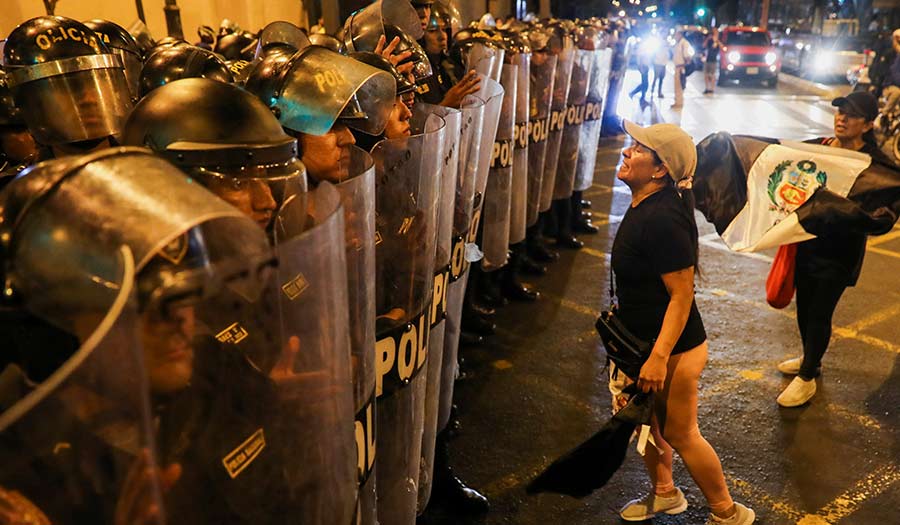 REUTERS/Sebastian Castaneda
REUTERS/Sebastian Castaneda
World News Desk
Learn the why behind the headlines.
Subscribe to the Real Truth for FREE news and analysis.
Subscribe NowThousands took to the streets of Peru’s capital Lima on Thursday in a protest against the new government and president, after weeks of bloody clashes triggered by the ousting of former President Pedro Castillo left at least 42 dead. This has been the Andean country’s worst outbreak of violence in over 20 years, as demonstrators call for systemic political changes and accountability for the deaths.
“Why are you turning your back on the people, there are so many deaths, for God’s sake, stop this massacre,” said protester Olga Espejo, calling on President Dina Boluarte, previously Mr. Castillo’s vice president, to resign.
“Ms. Boluarte, they are using you,” she said.
Protesters shouted “Dina asesina!” (Dina is a murderer) as they carried cardboard coffins, photos of the victims and anti-government slogans down the streets of Lima in the capital’s first mass protest since the start of 2023.
What Sparked the Protests?
Protests began after Congress removed President Pedro Castillo on December 7, who was arrested and sentenced to 18 months of pre-trial detention on rebellion charges.
Mr. Castillo was embroiled in multiple corruption investigations and tried to illegally dissolve Congress ahead of a planned impeachment vote.
His removal was the latest blow in a years-long clash between Peru’s executive and legislature. Mr. Castillo’s vice president, Dina Boluarte, ascended to the job as Peru’s sixth president in five years.
What Is Fueling the Protests?
Protesters are demanding Ms. Boluarte’s resignation, Congress’ closure, a new constitution and Mr. Castillo’s release. There have also been marches calling for an end to the unrest.
Allegations of undue force against protesters have fueled anger against Ms. Boluarte’s government. Human rights groups have accused authorities of using firearms on protesters and dropping smoke bombs from helicopters. The army says protesters have used weapons and homemade explosives.
Peru’s top prosecutor’s office on January 10 said it launched an inquiry into Ms. Boluarte and members of her cabinet on charges of “genocide, qualified homicide and serious injuries” amid the protests.
While Thursday’s protest was underway, Labor Minister Eduardo Garcia announced his resignation on Twitter, saying the country needs an apology for the deaths and urged the government to recognize that “mistakes have been made that must be corrected.”
Mr. Garcia said the situation could not wait until April 2024, when elections have been proposed, two years earlier than required.
The crisis has touched tourist hub Cusco, which again closed its airport on Thursday, and the country’s key mining sector, which saw a large copper mine struck by attackers and a tin mine shuttered in solidarity for the dead.
Prime Minister Alberto Otarola said earlier on Thursday that Ms. Boluarte would not resign, citing constitutional requirements to consolidate the succession, “not because she does not want to.”
“Leaving the presidency would open a very dangerous floodgate for anarchy and misrule,” he said.
What Is Happening at Protests?
Protesters have blockaded highways, set buildings on fire, and invaded airports, causing tens of millions of dollars in damage and lost revenue. Blockades have disrupted trade, grounded flights and stranded tourists.
Security forces have responded with violence. Victims have included civilians who were not protesting.
The Inter-American Commission on Human Rights has condemned violence by both security forces and protesters and called for dialogue. Protesters have so far refused to start talks with Ms. Boluarte.
Who Is Pedro Castillo?
Voters elected Mr. Castillo, a socialist, from a crowded field of candidates in 2021, following years of political crises and during a pandemic that hit Peru harder than most countries.
A little-known teacher and union leader from a poor Andean village, Mr. Castillo had no experience in elected office or ties to the Lima establishment.
Mr. Castillo’s supporters had high hopes he could bring better representation to poor, rural and indigenous Peruvians while standing up to elites.
Once in office, however, his support tumbled amid corruption scandals, party infighting, and congressional opposition. Mr. Castillo struggled to govern, naming five prime ministers and more than 80 ministers during his short presidency.
Still, Mr. Castillo retained supporters, who see him as a victim of political elites and a Congress that is widely unpopular and considered corrupt. Mr. Castillo’s 27 percent approval rating in a November IPSOS poll was still higher than Congress’ 18 percent.
Where Are the Protests?
Protests have occurred nationwide, but Peru’s long marginalized, left-leaning south has been their epicenter and the site of the worst violence.
The largely indigenous region has for centuries been at odds with the capital, which long dominated national politics. Mr. Castillo was just the second president born outside of Lima to be elected since 1956.
Although poverty fell in recent decades, a gap in living standards persists between the region and the capital. Despite local copper and gas wealth in the south, indicators including life expectancy and infant mortality lag those in Lima.
Peru’s south is also home to economically and culturally important tourist destinations such as Cusco and the nearby Inca citadel of Machu Picchu, from where over 2,000 tourists had to be evacuated in early January due to protests.
This report contains information from Reuters.
- Real Truth Magazine Articles
- POLITICS
 Government Solution?
Government Solution?


